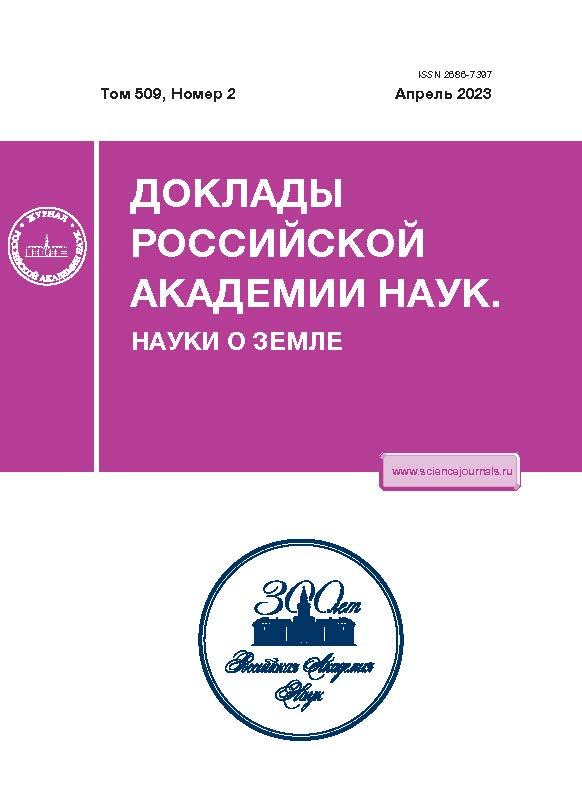FORMATION OF WINTER SURFACE TEMPERATURE ANOMALIES IN THE NORTH ATLANTIC IN DECADES OF NEGATIVE AND POSITIVE VALUES OF THE NORTH ATLANTIC OSCILLATION INDEX
- Authors: Sizov A.A.1, Bayankina T.M.1, Pososhkov V.L.1
-
Affiliations:
- Marine Hydrophysical Institute, Russian Academy of Sciences
- Issue: Vol 509, No 2 (2023)
- Pages: 259-264
- Section: CLIMATIC PROCESSES
- Submitted: 30.01.2025
- Published: 01.02.2023
- URL: https://edgccjournal.org/2686-7397/article/view/649694
- DOI: https://doi.org/10.31857/S2686739722602824
- EDN: https://elibrary.ru/NZHQSC
- ID: 649694
Cite item
Abstract
An analysis of the variability of the winter surface temperature anomaly in the North Atlantic in decades of negative and positive values of the North Atlantic Oscillation Index is presented. It was found that in the decade with negative values of the North Atlantic Oscillation Index, the slope waters of the Gulf Stream system and Labrador Current waters decrease the temperature of the Gulf Stream at the mixing zone on the Scotia Peninsula shelf and in the area of the quasistationary anticyclonic vortex to a maximum. In the decade with positive values of the North Atlantic Oscillation Index, the temperature of the slope waters is close to the climate. Taking into account the increased speed of the Gulf Stream in the years with positive values of the North Atlantic Oscillation Index, the spreading of the surface ocean temperature anomaly over the North Atlantic water area occurs for a shorter time than in the years with its negative values.
About the authors
A. A. Sizov
Marine Hydrophysical Institute, Russian Academy of Sciences
Author for correspondence.
Email: sizov_anatoliy@mail.ru
Russian Federation, Sevastopol
T. M. Bayankina
Marine Hydrophysical Institute, Russian Academy of Sciences
Author for correspondence.
Email: bayankina_t@mail.ru
Russian Federation, Sevastopol
V. L. Pososhkov
Marine Hydrophysical Institute, Russian Academy of Sciences
Email: bayankina_t@mail.ru
Russian Federation, Sevastopol
References
- Greene Ch.H., Meyer-Gutbrod E., Monger C., et al. Remote Climate-forcing decadal-scale regime shifts in Northwest Atlantic shelf ecosysteme // Limnology and Oceanography. 2013. V. 58. № 3. P. 803–816. https://doi.org/10.4319/lo.2013.58.3.0803
- Hurrell J.W., Deser C. North Atlantic climate variability: The role of the North Atlantic Oscillation // Journal of Marine Systems. 2009. V. 78 № 1. P. 28–41. https://doi.org/10.1916/j.jmarsys.2008.11.026
- Proshutinsky A., Dukhovskoy D., Timmermans M.-L. Krishfield R., Bamber J.L. Arctic circulation regimes // Phil. Trans. R. Soc. 2015. A373:20140160. https://doi.org/10.1098/rsta.2014.0160
- Баранов Е.И. Структура и динамика вод системы Гольфстрим. М.: Гидрометеоиздат, 1988. 252 с.
- Taylor A.H., Stephens J.A. The North Atlantic Oscillation and the latitude of the Gulf Stream // Tellus A: Dynamic Meteorology and Oceanography. 1998. V. 50. № 1. P. 134–142. https://doi.org/10.3402/tellusa.v50il.14517
- Hirschi J.-M., Barnier B., Böning C., Biastoch A., Blak A., et al. The Atlantic Meridional Overturning Circulation in High-Resolution Models // Journal of Geophysical Research: Oceans. 2020. doi.org/https://doi.org/10.1029/2019JC015522
- Нестеров Е.С. Североатлантическое колебание: атмосфера и океан. М.: Гидрометеоиздат. 2013. 127 с.
- Curry R.G., McCarthy M.S. Ocean Gyre Circulation Changes Assosiated with the North Atlantic Oscillation // Journal of Physical Oceanography. 2001. V. 31. № 12. P. 3374–3400.
- Fuglister F.C. Gulf Stream '60*// Progress in oceanography. 1963. V. 1. P. 265– 383.
- Бондаренко А.А., Борисов В.С., Серых И.В., Суркова Г.В., Филиппов Ю.К. Закономерности формирования апвеллинга Мирового океана // Метеорология и гидрология. 2012. № 11. С. 75‒81.
- Breeden M.L., McKinly G.A. Climate impacts on multidecadal pCO2 variability in the North Atlantic: 1948–2009 // Biogeosciences. 2016. № 13. P. 3387–3396. https://doi.org/10.5194/bg-13-3387-2016
- Sizov A.A., Bayankina T.M., Pososhkov V.L, Anisimov A.E. Processes Determining Synchronous Interdecadal Variability of Surface Temperature in the Barents and Black Seas // Physical Oceanography. 2022. V. 29. № 3. P. 257‒270. https://doi.org/10.22449/1573-160X-2022-3-257-270
Supplementary files











